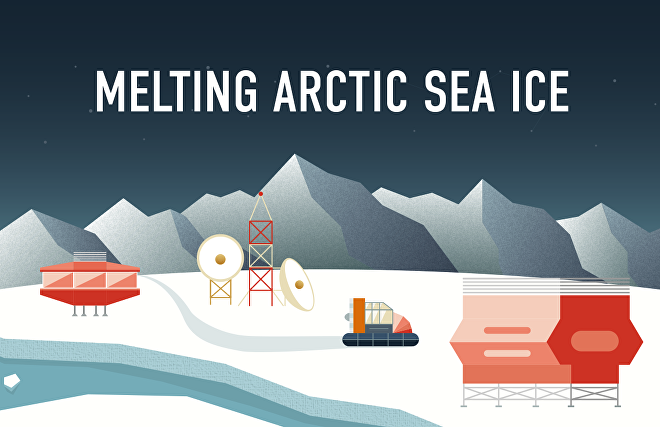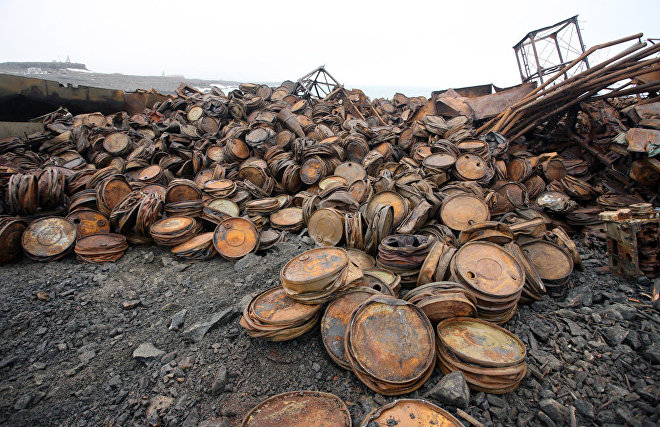During summer, the Arctic receives many hours of sunlight; however, snow and ice surfaces reflect much of it, softening the radiation — this phenomenon is known as the albedo effect.
Also, the sun's low angle above the horizon creates shading by even minor topographic features such as low hills. This too limits heat gain, and results in a variety of local microclimates.
Maritime (ocean-tempered) conditions prevail over the Arctic Ocean, coastal Alaska, Iceland, northern Norway, and adjoining coastal sections of Russia. These locations undergo cold and stormy winters, while summers are mild, with mean temperatures of about 10˚ C. Annual precipitation averages between 60 and 125 centimeters, with about six months of snow cover. Coastal areas may experience hurricane-force winds that persist for days, or even weeks.
In the interior, continental stretches of the Arctic, winters are far harsher than on the coasts, although cloud cover and, therefore, precipitation are reduced. Here, permafrost is widespread and often deep. During summer, typically one to two meters of the ground thaw and remain mostly waterlogged. However, permafrost temperatures have been rising due to climate change, and thawing is penetrating deeper in some areas.
While frost may occur in any month, long summer days usually provide three months with mean temperatures above 10° C.
The most favorable weather conditions are found in the Atlantic-European part of the Arctic. Thus, in January, the mean temperature at Svalbard is about — 17°C. The reason is that cyclones are quite common in this part of the Arctic in winter; they bring warm air from the Atlantic, but with them come heavy precipitation and strong wind. March is the coldest month of the year in that area. In summer, the temperature in the Atlantic-European part of the Arctic is about 10°C. The climate of Greenland is the most severe; about 80% of the island is covered with ice.
The average depth of the Greenland Ice Shield is 2,135 m. The sheet's thickness reaches up to 3,000 m. The age of the ice is estimated at about 110,000 years. The sheet lies at the island's center, is separated by a strip of land from the sea, and in places its borders run along the coast.
In the southern part of the island the mean winter temperature is about —10°C, in the north it is — 30° C, and in the center it is about — 50°C. Summer in Greenland is also cold: in the central part of the island it is — 14°C, and in the south the temperature rises up to +10°C.
Low-pressure systems, such as the Icelandic Low and the Aleutian Low, control the weather in many Arctic and subarctic areas. These systems generally are weak during summers, but stronger in winters. In contrast, high pressure (the Siberian High) dominates eastern Eurasian winters. Year-round, the strongest average winds occur in the North Atlantic seas (Barents, Greenland, etc.), Baffin Bay, and the Bering and Chukchi seas, where cyclone activity is most common. On the Atlantic side, winter wind speeds can approach 180 km/h.
Arctic precipitation occurs mostly as snow, with less than 50 centimeters of precipitation falling annually in most areas. However, meteorological observations show that precipitation levels across the region vary by almost a factor of 10, with some parts of the Arctic Basin and Canadian Archipelago receiving less than 150 millimeters (mm) annually, while parts of southeast Greenland get more than 1200 mm annually.
Average January temperatures range from about —40 to 0° C (-40 to +32° F), while winter temperatures can drop below —50° C (-58° F) over large parts of the Arctic. Average July temperatures range from about —10 to +10° C (14 to 50° F), with some land areas occasionally exceeding 30° C (86° F) in summer.

